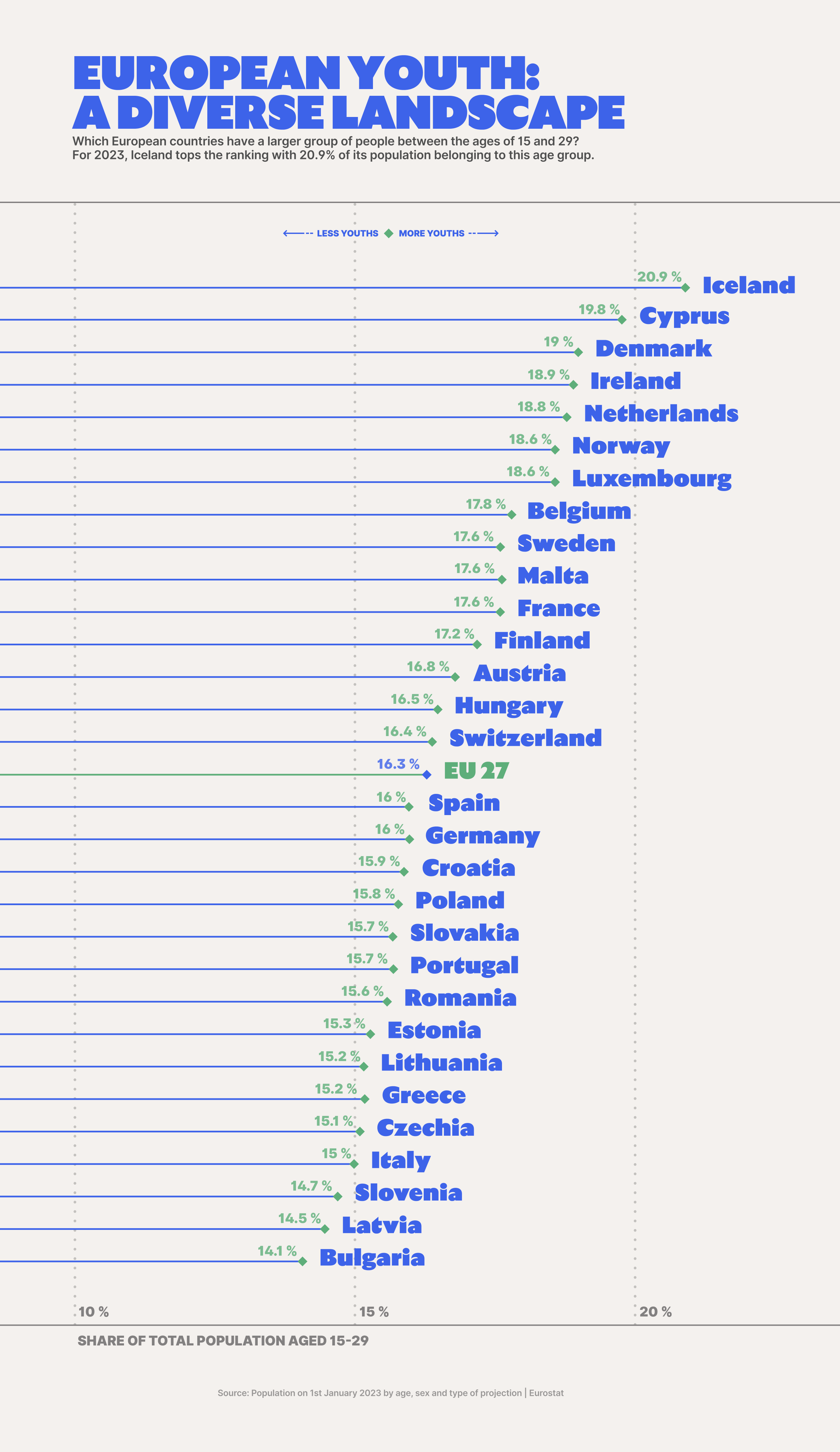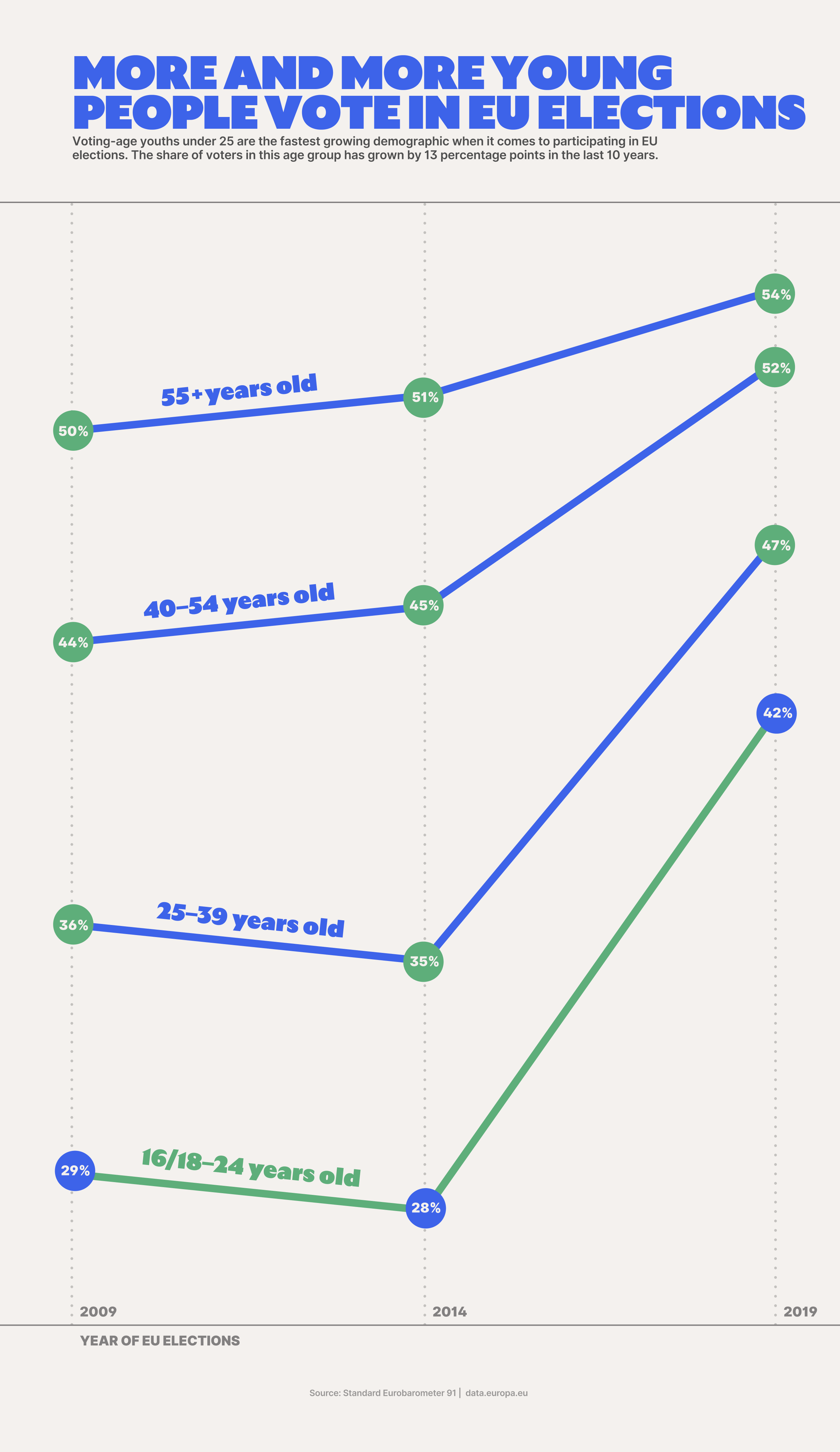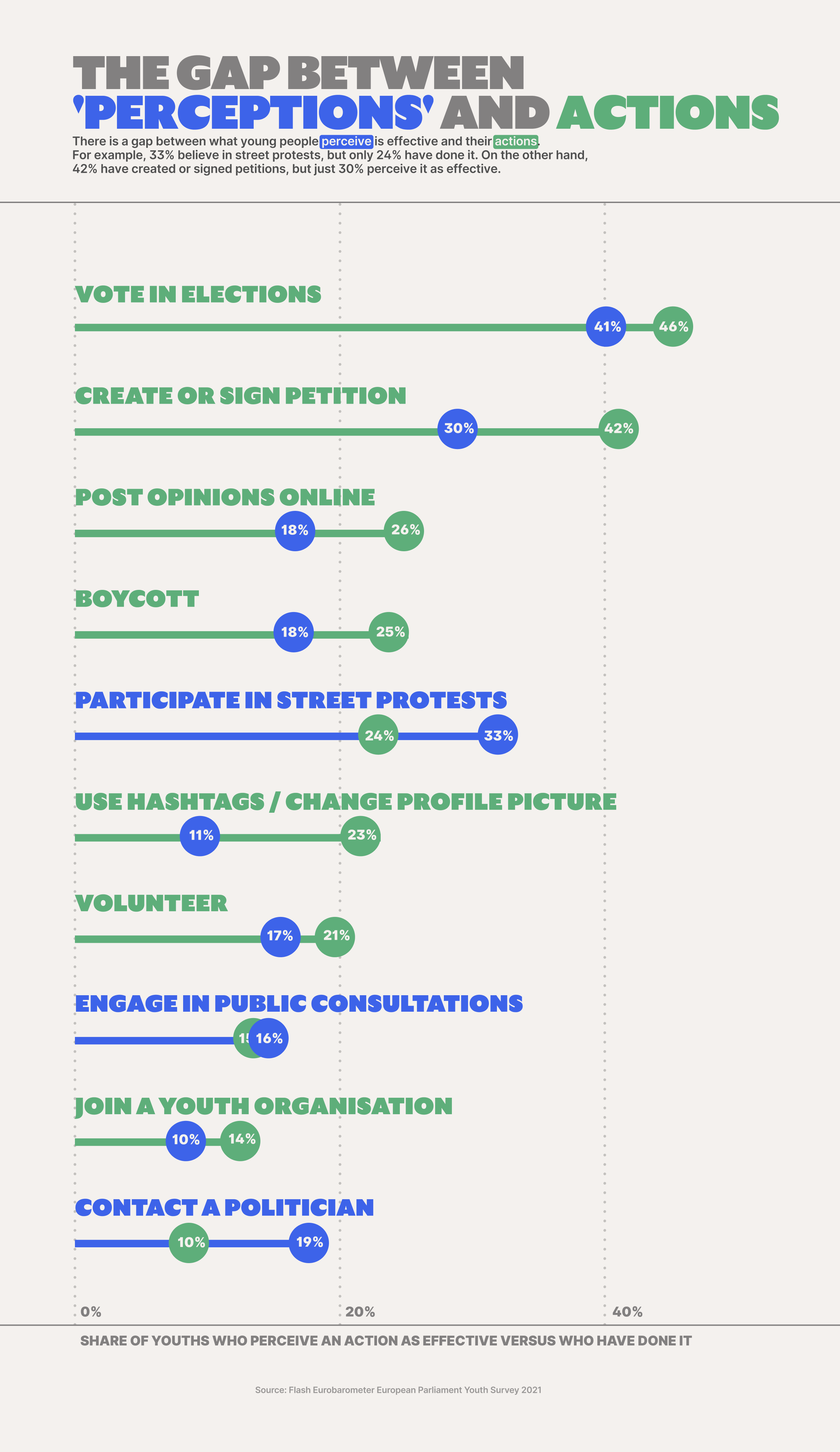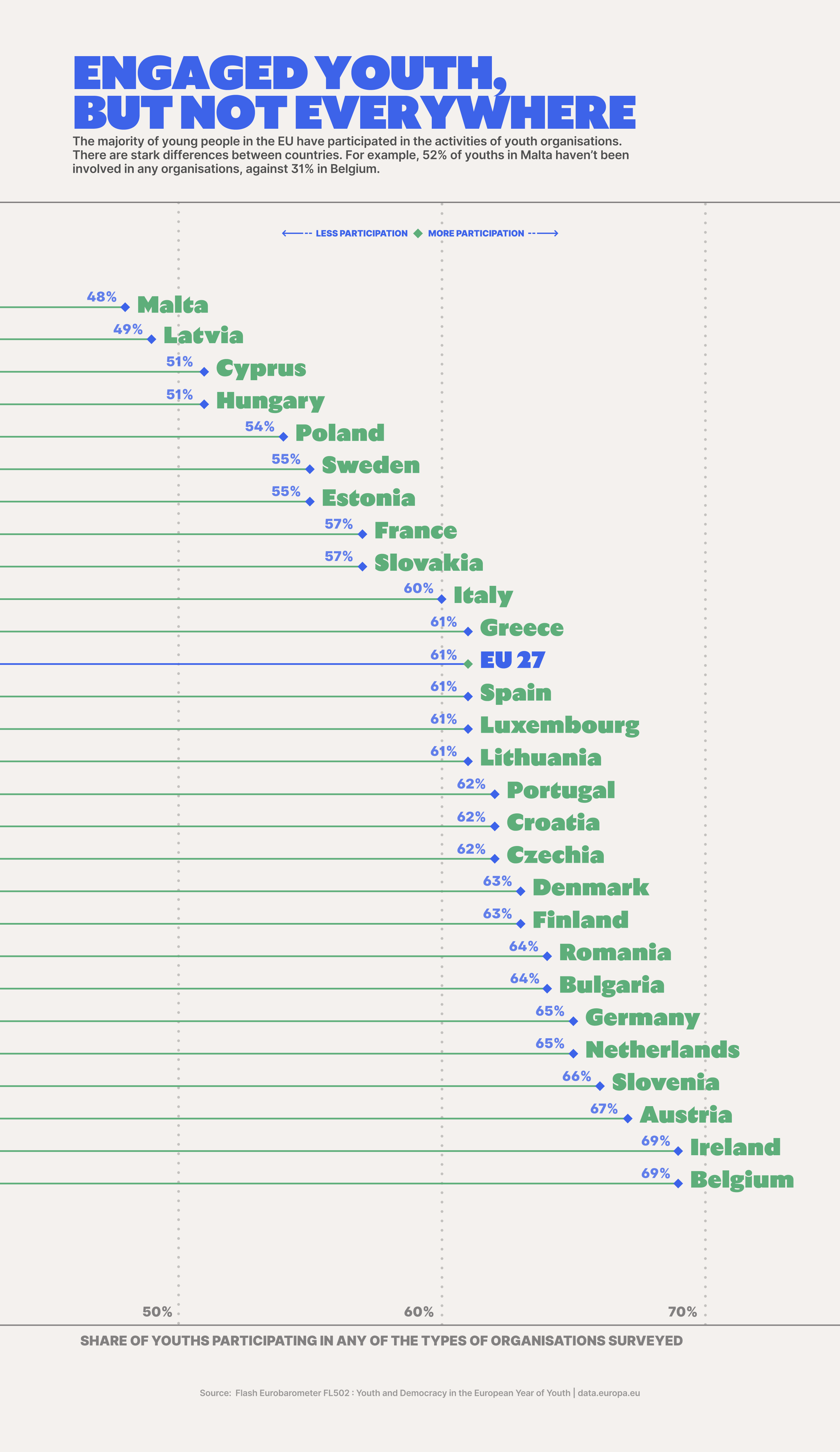Understanding youth engagement in Europe through open data
Open data sheds light on the state of youth engagement in Europe
European democracy is strengthened when citizens actively participate in political and civic life. The active involvement of Europe’s young citizens is especially important since the attitudes and opinions of young people foreshadow future trends and developments in society. But how are young people in Europe participating? Are they engaged in civil society?
Data can be an essential element to understand what young people care about and how they are involved. International Youth Day took place on12 August, as an opportunity for governments to draw attention to youth issues worldwide. Following this initiative, the purpose of the data story is to show, by relevant open data from the EU, how young people in Europe are engaged with our democracy and how they get actively involved.
Youth and EU elections in numbers
Young people can bring fresh ideas and diverse perspectives for a better decision-making. Including them in the democratic process helps ensure that policies and decisions address the needs that young people have and the challenges they face. Also, by participating in elections and civic activities, an engaged youth population contributes to a political system that reflects the interests of all its citizens. This in turn fosters a peaceful and inclusive society.
That is why the European Union ‘wants young people to engage and become active citizen[s] involved in democracy and society’. The EU has developed a Youth strategy to help achieve this goal. Figure 1 shows how young people (aged 15–29 years) make up 16.3 % of the EU’s total population in 2021, according to Eurostat. However, the range is diverse across Europe, for example showing a proportion of young people from 14.1% in Bulgaria to 20.9% in Iceland.

Figure 1: Youth population in Europe (source: Eurostat)
Regarding the participation in EU elections, the 2019 post-electoral Eurobarometer survey of the EU is one of the most comprehensive quantitative surveys publicly available that analyses citizens’ voting behaviour. It showed the highest voter turnout in over 20 years, with more than half of the Europeans voting. The survey concluded that the increase in turnout was driven by a rise in turnout among young people.
Figure 2 shows the increase of EU elections turnout over time. Although people above 40 remain more likely to vote in EU elections than younger people, voting by the younger generation (aged under 25) increased in 14 percentage points to 42 %, and 12 percentage points to 47 % for people aged 25 to 39, from the 2014 to the 2019 European elections. What might explain this boost in turnout? According to the 2021 Eurobarometer Youth Survey, a sense of duty as a citizen (32 %) and willingness to take responsibility for the future (32 %) were the main motivating factors for young people voting in the European elections.

Figure 2: Voting groups by age in the 2009, 2014 and 2019 European Parliamentary elections (sources: Special Eurobarometer 71.3: Post-electoral survey 2009 and Eurobarometer 2019 91.5 QG1: The 2019 post-electoral survey)
Given the increase in the turnout of young voters, what were young people thinking and doing in the run up the 2019 European elections? The 2019 post-election survey also revealed the trends in voting behaviour of voters. Young voters were most likely to decide only a few weeks or months before the elections that they would vote (29 %; compared with the EU average of 23%), most likely to hesitate between different parties (45%; compared with the EU average of 33%) and most likely to choose a party based on that party’s proposals on European issues that they cared about (48 %; compared with the EU average of 43%). The voting behaviour of young people matters because it reflects their values and priorities. And over the long term, the values, beliefs and priorities of the youth shape the direction in which society and governance progress.
Other forms of civic engagement
Although voting in elections is a very important form of participation in our democracy, there are other forms to demonstrate active citizenship. The 2021 Youth Survey showcases data about the general interest of young people, and which activities they are involved in.
In general, politics is a topic of interest for young people in Europe. Most of young respondents in the 2021 Youth Survey said they discuss politics with friends or relatives (85 %). Many also say they understand how the national government of their country works (58 %) (understanding of the local government and of the EU is slightly lower). However, most youths feel they do not have much influence over important decisions, laws and policies affecting them. In this regard, young people feel they have more say in their local government (47 %) than in the national government (40 %) or at the EU level (30 %).
A next step after understanding and discussing politics is to take action. Young people believe certain political and civic activities are more effective than others to make one’s voice heard by decision-makers. Survey respondents in the 2021 Youth Survey placed voting in elections (41 %), taking part in street protests or demonstrations (33 %) and participating in petitions (30 %) as the top three most effective activities. The flip side of perceiving activities to be effective is putting those beliefs into action. Indeed, many young people reported that they had voted in their last local, national or European elections (46 %). Many had also created or signed a petition (42 %).
The 2021 Youth Survey asked respondents what actions they perceive as effective and what activities they have participated in as separate questions. Cross-analysing these responses reveals a new insight from the survey data: there is sometimes divergence between perceptions and actions (Figure 3). This divergence applies in both directions. On the one hand, young people sometimes take action despite not perceiving it to be the most effective. For example, young people show high participation in petitions even though they do not necessarily believe that it will be that effective. It is the same with online activities such as posting opinions or changing their profile picture. Young people participate in these online activities even though they do not necessarily think it will have the strongest impact. On the other hand, young people do not always perform the actions they perceive as effective. For example, young people believe that street protests or contacting a politician are both effective actions, but they have a low participation in these activities. But overall, perceptions are not holding young people back from taking action. Youths do not match their activity to its perceived effectiveness for only 3 of the 10 actions (see blue bars in Figure 3) in the survey options. Do you wonder if older age groups show the same trends? Only enriching this dataset with complementary open datasets about other age groups can answer your curiosity!

Figure 3: Comparison between what actions youth have taken to be heard versus which activities they perceive as effective (source: Flash Eurobarometer European Parliament Youth Survey)
Participation in civic society also encompasses volunteering, leisure and cultural activities. Another special Eurobarometer on youth and democracy (2022) explored this topic. More than half of young people participated in the activities of at least one youth organisation in the year preceding the study (58 %). The most popular type of youth organisation reported by survey respondents is a sports club (24 %), followed by an organisation for volunteering activities (17 %) and leisure-focused clubs (15 %). However, youth participation is uneven across the EU, with youths in several countries reporting that they do not participate in such activities. The main reason given by survey respondents for not participate in these activities is due to a lack of time (39 %). Other reasons given by those who do not participate include a lack of interest (25 %), not having thought about participating (23 %) and not having been invited to take part (22 %). Figure 4 shows the participation of youth in these activities based on the results of this special Eurobarometer.

Figure 4: Common youth participation activities in Europe (source: Flash Eurobarometer FL502: Youth and democracy in the European year of youth)
Looking ahead at European democracy
Youth will want to see their priority issues on the political agenda at the upcoming European elections. The 2021 Youth Survey revealed that young people are generally in favour of the EU (62 %). A more recent special Eurobarometer on democracy in action (2023) similarly found that young people aged 15 to 24 are the most satisfied age group with how democracy works in the EU (61 %; the EU average is 54%). But what issues do young people see as a priority? Respondents in the 2021 Youth Survey put tackling poverty and inequality (43 %), combatting climate change and protecting the environment (39 %), and combatting unemployment (37 %) as political issues they want prioritised. Respondents in the Eurobarometer on democracy in action gave consistent top priorities, but an additional insight is that young respondents (aged 15–24) prioritise action against climate change more than the general population (40 % vs 31 %).
To bolster youth engagement in Europe’s political agenda, several initiatives use open data to bring politics closer to citizens. TrackmyEU is an app that aims to bring EU decision-making closer to citizens. Using open data, the app allows citizens to find information on EU policies and sort, rank and filter this information based on their interests and preferences. Another app, Democracy Game, was created with the purpose of getting young people engaged in politics. The app plans to host virtual debates, competitions and polls. Citizens will be able to visit a virtual townhall, discover EU datasets and connect with peers. These initiatives won awards at the EU Datathon.
Conclusion
Youth participation in elections and engagement in civic life is essential to strengthen European democracy. Thanks to open datasets, we can see the state of play of youth participation and engagement in Europe and provide evidence to governments and public administrations on the topics of their interest. Indeed, the majority of young people in Europe are talking about politics, driving increased election turnout at European elections, and participating in youth organisations. They care about inequality and climate change, among many other major challenges of our century. In addition, the rich data reflected in these extensive surveys such as the Eurobarometer uncover further patterns and trends in youth attitudes and behaviours. Open data can, moreover, be used in initiatives that promote youth participation in political and civic life.
Do you have questions about youth engagement and democracy in Europe? Translate your curiosity into insights with open datasets on data.europa.eu. Also, stay tuned for our next data stories and webinars by subscribing to our newsletter and following data.europa.eu on social media.
Method note: the Eurobarometer surveys referenced in this data story have slight differences in their technical specifications. The post-electoral survey considers young people to be aged 16/18 to 24. Respondents to the 2021 youth survey are aged 16 to 30. The youth and democracy survey included respondents aged 15 to 30 years. The democracy in action survey considers young people to be aged 15 to 24.
Data visualisations by Matteo Moretti and Alice Corona
